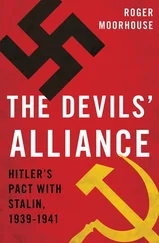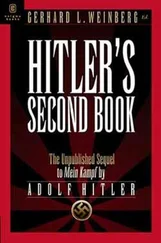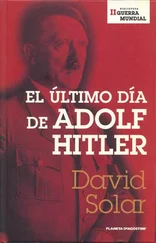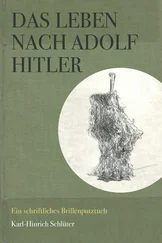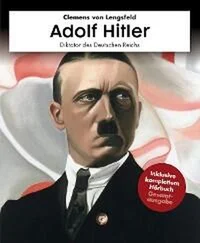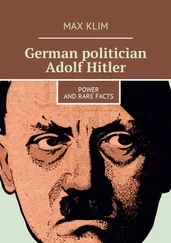Christa Schroeder - He Was My Chief - The Memoirs of Adolf Hitler's Secretary
Здесь есть возможность читать онлайн «Christa Schroeder - He Was My Chief - The Memoirs of Adolf Hitler's Secretary» весь текст электронной книги совершенно бесплатно (целиком полную версию без сокращений). В некоторых случаях можно слушать аудио, скачать через торрент в формате fb2 и присутствует краткое содержание. Город: Barnsley, Год выпуска: 2012, ISBN: 2012, Издательство: Frontline Books, Жанр: История, Биографии и Мемуары, на английском языке. Описание произведения, (предисловие) а так же отзывы посетителей доступны на портале библиотеки ЛибКат.
- Название:He Was My Chief: The Memoirs of Adolf Hitler's Secretary
- Автор:
- Издательство:Frontline Books
- Жанр:
- Год:2012
- Город:Barnsley
- ISBN:978-1-7830-3064-4
- Рейтинг книги:4 / 5. Голосов: 1
-
Избранное:Добавить в избранное
- Отзывы:
-
Ваша оценка:
- 80
- 1
- 2
- 3
- 4
- 5
He Was My Chief: The Memoirs of Adolf Hitler's Secretary: краткое содержание, описание и аннотация
Предлагаем к чтению аннотацию, описание, краткое содержание или предисловие (зависит от того, что написал сам автор книги «He Was My Chief: The Memoirs of Adolf Hitler's Secretary»). Если вы не нашли необходимую информацию о книге — напишите в комментариях, мы постараемся отыскать её.
He Was My Chief: The Memoirs of Adolf Hitler's Secretary — читать онлайн бесплатно полную книгу (весь текст) целиком
Ниже представлен текст книги, разбитый по страницам. Система сохранения места последней прочитанной страницы, позволяет с удобством читать онлайн бесплатно книгу «He Was My Chief: The Memoirs of Adolf Hitler's Secretary», без необходимости каждый раз заново искать на чём Вы остановились. Поставьте закладку, и сможете в любой момент перейти на страницу, на которой закончили чтение.
Интервал:
Закладка:
2
Univ. Pennsylvania, Charles Patterson Van Pelt Library, microfilm 46M-11FU US Army 101st Airborne Division, Counter-Intelligence Corps, 22.5.1945.
3
Anni Brandt née Rehborn (b. Langenberg 25.8.1904). German Ladies’ national swimming champion (crawl and backstroke) during 1923–9 period; 1928 Olympic Games Amsterdam; introduced to Hitler 1925 and from then until 1945 part of his intimate circle at the Berghof. Married surgeon Dr Karl Brandt 17.3.1945, one child: taken into US custody April 1945.
4
SS-Gruppenführer Dr (med.) Karl Brandt (b. 8.1.1904 Mühlhausen, Alsace, d. 2.6.1948 Landsberg Prison, executed as war criminal). Dr Brandt was arrested by the SS on 16 April 1945 for defeatism after sending Hitler a letter on 1 April 1945 expressing doubt in final victory, and sending his wife and child to Bad Liebenstein so that they would fall next day into American and not Russian hands. On 17 April 1945 he was condemned to death by court martial but was still at Kiel awaiting execution when Hitler’s death was announced, and Speer had him freed.
5
Following Hitler’s release from Landsberg Prison, the NSDAP was reconstituted on 17 February 1925 in a single room at the premises of a publisher at Thierschstrasse 15. As this room was soon inadequate for the membership, on 4 June 1925 several rooms were rented in a building at the rear of Schellingstrasse 50. Although further parts of the premises front and back continued to be rented, the needs of the Party administration soon outgrew them.
6
Oberst Wilhelm Brückner (b. 11.12.1884 Baden-Baden, d. 18.8.1954 Herbstdorf, Traunstein). First World War military service France and Romania, 1918 oberleutnant. 1919 Reichswehr and Freikorps Epp, Munich. 1922 SA-Führer (Munich Regt): involved in failed putsch 1924. 1925–8 active as sports trainer. 1.8.1930 Hitler’s adjutant. 1.7.1932 SA-Oberführer. 1.3.1933 SA-Gruppenführer, 1.9.1934 SA-Obergruppenführer, chief adjutant. 18.10.1940 dismissed by Hitler, rejoined army in rank of major, served in France: 1.12.1944 oberst: 4.5.1945 while hospitalised for a wound at Traunstein interned by US Army: released 22.9.1948.
7
Johanna Wolf (b. 1.6.1900 Munich, d. 5.6.1985 Munich). 1923 private secretary to Hitler’s mentor Dietrich Eckart; 1922–8 secretary to Landtag ‘Völkischer Block’ deputy Dr Alexander Glaser; 5.1928 secretary to Gregor Strasser; 1929 employed by Hitler’s private chancellery; 1.11.1929 joined NSDAP, secretary to Rudolf Hess; from 1930 secretary to Hitler’s adjutant Wilhelm Brückner; 1933 transferred to Berlin with Hitler’s Chancellery and attached to Personal Adjutancy as Hitler’s personal secretary. Was often unwell and did not stand flights and road journeys well. Hitler always protected her against efforts to have her replaced. Left Berlin on Hitler’s order 21.4.1945; arrested by US forces at Bad Tölz, 23.5.1945; interned; opposed to Frau Schroeder’s negotiations with Zoller; released 14.1.1948.
8
Johanna Nusser was a long-term friend of Frau Schroeder with whom she maintained an intimate correspondence during the war. She spoke on her behalf at the war crimes tribunal hearing and helped Frau Schroeder after her release in 1948. In the 1950s Frau Nusser returned a batch of letters written to her by Schroeder during the war and allowed her to pass another batch to the historian David Irving. The latter are now at the Institut für Zeitgeschichte.
9
Generaloberst der Artillerie Alfred Jodl (b. 10.5.1890 Würzburg, d. 16.10.1946 executed Spandau). From 23.8.1939 Chief of Wehrmacht Policy Office (later Wehrmacht Policy Staff) at FHQ. As Hitler’s chief of staff advised him on tactical and strategic matters; 7.5.1945 Wehrmacht signatory to partial capitulation to Western Allies, Rheims; interned 23.5.1945 Mürwik; 30.9.1946 sentenced to death as war criminal.
10
From 1936 Hitler’s house on the Obersalzberg was given the name ‘Berghof’. Hitler’s Staff and the inner circle always referred to it as ‘the Berg’. On 2.2.1942 at FHQ Wolfsschanze, Hitler stated that the Berghof was also ‘Gralsburg’ (The Grail Fortress). Heinrich Heim: Adolf Hitler, Monologe im FHQ , 1941–1944.
11
‘Baltic fighters’ were members of the various German Freikorps who united with Baltic nationals in 1918–19 to resist the advance of the Red Army and secure the German eastern border. In the autumn of 1919, Germany had about 420,000 Freikorps men under arms. Many of these militants went later to the NSDAP.
12
When the rented premises at Schellingstrasse 50 were no longer adequate for the NSDAP Reich leadership, on 5 July 1930 Hitler bought for RM 1.5 million the former Barlow Palace at Briennerstrasse 45. Built in 1928 it was converted by Professor Troost and Hitler, and was enlarged. Renamed ‘Braunes Haus’ on 1 January 1931, it housed the NSDAP Reich leadership on three floors. Later other buildings were purchased including two during the reconstruction of the Königsplatz on Arcisstrasse which remain standing today.
13
The title means ‘Notes by a Confidante’.
14
Franz Felix Pfeffer von Salomon (b. 19.2.1888 Düsseldorf, d.12.4.1968 Munich). Pfeffer remained in Munich without an office after his withdrawal but lived with Party associates until elected to the Reichstag on 6.11.1932. In 1933 police commissioner in Kassel; 1938 president, provincial government at Wiesbaden; 1944 briefly under arrest in connection with July Plot; interned by Allies; released 1946.
15
Gregor Strasser (b. 31.5.1892 Geisenfeld, d. 30.6.1934 Berlin). 9.6.1932 head NSDAP Reich Organisational Directorate; 8.9.1932 resigned from Party activities after accusation of disloyalty by Hitler in the Schleicher affair; expelled from the Party, returned to industry in Berlin; murdered by Gestapo by shooting at their Prinz-Albrecht-Strasse prison.
16
Otto William Heinrich Wagener (b. 29.4.1888 Durlach/Baden, d. 9. 8.1971 Chieming-Stöttham/Bavaria). Took over position of acting OSAF from Salomon until 31.12.1930; from 1.1.1931 head of Economic-Political Office (WPA) at Braunes Haus; 4.9.1932 resigned office, attached to Führer-Staff for special purposes, Berlin; 20.4.1933 resumed former WPA post; 3.5.1933 Reich commissioner for trade and industry; 12.6.1933 relieved of all posts after Hitler and Göring suspected him of lobbying for post of minister for industry; following USCHLA hearing cleared of all involvement; end 1933 Reichstag deputy Koblenz-Trier; 30.6.1934 arrested in Röhm purge, released and returned to Erzgebirge to farm, but remained Reichstag deputy until 1938 and SA-Gruppenführer; fought in the Second World War; PoW (British) 1944 in rank of major general; 1947 convicted in Italy of war crimes; 1952 released.
17
USHLA = Untersuchungs- und Schlichtungsaussschuss , NSDAP Reich Leadership Committee of Investigation and Reconciliation, renamed ‘The Supreme Party Court’ by Hitler on 31.3.1933. Its purpose was to ‘protect the collective honour of the Party and its individual members, and where necessary to settle differences between individual members in an amicable way’.
18
The SA personal injury insurance scheme started with the Giesinger SA in Munich and at the beginning of 1927 was extended to cover the entire SA under the administration of OSAF in a special sub-division Versicherungswesen . By 1 January 1928 it was so well capitalised that only death and invalidity was reinsured out. When the reinsurer demanded a hefty rise in premiums at the end of 1928 for increased risk, OSAF abandoned reinsurance altogether and under the direction of Martin Bormann from 1 January 1929 the insurance was turned into a giant Party enterprise with no private involvement, being known as the NSDAP Hilfskasse from 1 September 1930.
Читать дальшеИнтервал:
Закладка:
Похожие книги на «He Was My Chief: The Memoirs of Adolf Hitler's Secretary»
Представляем Вашему вниманию похожие книги на «He Was My Chief: The Memoirs of Adolf Hitler's Secretary» списком для выбора. Мы отобрали схожую по названию и смыслу литературу в надежде предоставить читателям больше вариантов отыскать новые, интересные, ещё непрочитанные произведения.
Обсуждение, отзывы о книге «He Was My Chief: The Memoirs of Adolf Hitler's Secretary» и просто собственные мнения читателей. Оставьте ваши комментарии, напишите, что Вы думаете о произведении, его смысле или главных героях. Укажите что конкретно понравилось, а что нет, и почему Вы так считаете.

